|
Once the snow and any long lasting penetrating frosts have finished it's time to get going on growing and sowing in earnest, and this is when cloches come into their own. Warming up your soil by cloching will help germination greatly, particularly when it comes to carrots, parsnips, spinach and beetroot. That's because these need warm soil, and covering the ground beforehand, for ten days or so, will help enormously. If it's been very wet, then a cloche will also prevent your seeds from becoming waterlogged. But don’t think cloches are useful just to get your seeds growing at the beginning of the season. They offer protection for your plants throughout the year from the weather, pests, animals, reducing weed growth. They will also keep the soil warm later into autumn, which is important if you want to get your hardy annuals sown early.
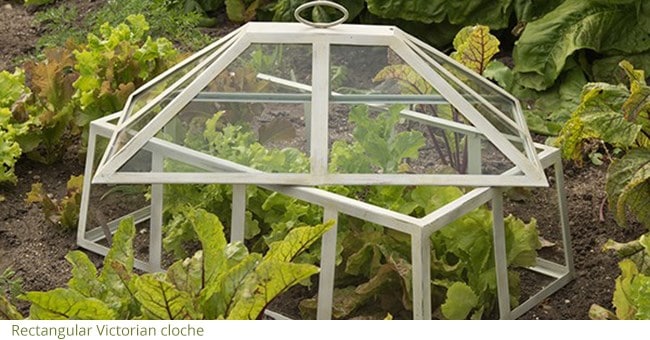
What are Cloches
Cloches are like movable greenhouses or polytunnels in your garden, and they come in varying shapes, sizes and materials. The solid clear cloches are heavy and durable enough to be invaluable for protecting your delicate plants through the winter months. The lighter forms are ideal for offering young autumn or spring vegetable seedlings protection and that extra bit of warmth. Other cloches in wire, bamboo or willow for instance are designed to give your plants protection from animals and pests, whilst still allowing air to circulate around the plant normally. Although cloches will protect your plants in most weathers, in severe weather conditions you may need to cover you cloches with horticultural fleece for added insulation.
History of cloches
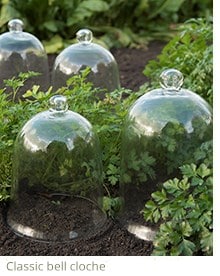 Cloching is an ancient art and the Romans were known to protect their cucumbers with glass covers. However it was the French who perfected the art of raising crops under glass. They used giant glass bell jars, which they called cloches. These were originally blown by Italian glassmakers in the late 16th century and reached the south of France a little later. Olivier de Serres (literally Oliver of the Greenhouses) used them to raise melons. The big glass hats became known as cloches in France, but they were expensive to produce and highly breakable. By 1677 square cloches with pieces of glass set in lead were being made in England. Often old window panes were used in their construction and, if a piece of glass broke it could be replaced. Both were highly decorative. They were propped up on wood during the day, or moved to one side and then replaced for the night. That method helped to harden off the crop. Cloching is an ancient art and the Romans were known to protect their cucumbers with glass covers. However it was the French who perfected the art of raising crops under glass. They used giant glass bell jars, which they called cloches. These were originally blown by Italian glassmakers in the late 16th century and reached the south of France a little later. Olivier de Serres (literally Oliver of the Greenhouses) used them to raise melons. The big glass hats became known as cloches in France, but they were expensive to produce and highly breakable. By 1677 square cloches with pieces of glass set in lead were being made in England. Often old window panes were used in their construction and, if a piece of glass broke it could be replaced. Both were highly decorative. They were propped up on wood during the day, or moved to one side and then replaced for the night. That method helped to harden off the crop.
Which Cloche to buy
Buying cloches should be considered as a garden investment for the future, so it's important to buy the right one for you. Ventilation is the key to success when covering plants because still, damp air will encourage fungal diseases like damping off and botrytis. So make time to either uncover your seedlings or young plants every day, exposing them to fresh air, or buy a cloche with a built-in ventilator like the Large ventilating cloche.
A 'bell' cloche has been around for years in various forms, and the traditional hand blown glass Classic bell cloche is still the staple for many gardens. Robust and practical, it keeps the soil warm while adding a lovely decorative touch to the border or vegetable patch. They don’t have ventilation at the top so you have to manage this yourself, but gardeners have been doing this for years!
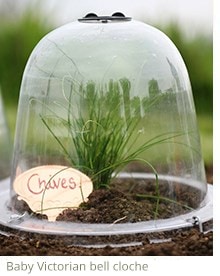 Glass cloches were, and still are traditionally used in the kitchen garden, but there are now clear plastic forms that look just like glass. The popular Original Victorian bell cloche sold as a set of 3 are clear plastic rigid bells with vented tops, providing temperature and humidity control to regulate the growing conditions. These lightweight cloches offer an easy solution for protecting your seeds or young plants in the garden or indoors. If you are using them on the allotment or the garden you will need to anchor them down by using ground pegs through the base holes. The Baby Victorian bell cloche is as the name suggests a compact form of the above, perfect for the smaller areas and young plants that need protection for a short time. Glass cloches were, and still are traditionally used in the kitchen garden, but there are now clear plastic forms that look just like glass. The popular Original Victorian bell cloche sold as a set of 3 are clear plastic rigid bells with vented tops, providing temperature and humidity control to regulate the growing conditions. These lightweight cloches offer an easy solution for protecting your seeds or young plants in the garden or indoors. If you are using them on the allotment or the garden you will need to anchor them down by using ground pegs through the base holes. The Baby Victorian bell cloche is as the name suggests a compact form of the above, perfect for the smaller areas and young plants that need protection for a short time.
The Open topped glass cloches come in 2 simple designs - domed or tapered and are sold singly or in sets of 3. I love these as they are simple and stylish, but still practical being heavy enough to withstand winds, and will protect your young plants from early frosts at the beginning of the season or to extend your growing season late into autumn. The open top makes it easy for watering and allowing good ventilation.
Highly Decorative and Practical Cloches
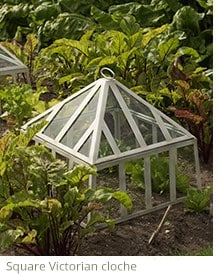 Modern reproductions add great style to productive kitchen gardens, potagers and wildflower areas, as well as giving protection to tender crops and plants. They often have a lid that can be lifted off on a warm sunny day or left ajar to allow a regulated amount of air to circulate around your plants, and makes it easy for watering. These elegant aged traditional rectangular or square 'Victorian’ cloches can be left out all year round. The chalky white powder coating mixes well with vegetables and annuals giving a vintage charm, making a real feature to focus the eye on. The contemporary Aluminium and glass lidded cloche has a similar lidded top. This is a tough heavy duty ventilated cloche that will withstand the weather and protect your plants, but still look stylish and contemporary on your allotment or in the border. Modern reproductions add great style to productive kitchen gardens, potagers and wildflower areas, as well as giving protection to tender crops and plants. They often have a lid that can be lifted off on a warm sunny day or left ajar to allow a regulated amount of air to circulate around your plants, and makes it easy for watering. These elegant aged traditional rectangular or square 'Victorian’ cloches can be left out all year round. The chalky white powder coating mixes well with vegetables and annuals giving a vintage charm, making a real feature to focus the eye on. The contemporary Aluminium and glass lidded cloche has a similar lidded top. This is a tough heavy duty ventilated cloche that will withstand the weather and protect your plants, but still look stylish and contemporary on your allotment or in the border.
Serious cloching
 On your allotment you might need something larger, longer and more serious for cloching your early seedlings, such as the Longrow super cloche. Measuring a generous 115m x 47cm x 25cm, you can use this with dwarf beans, strawberries, melons ,salad and all root crops. The circular end panels turn at a touch for adjustable ventilation and it has a rugged steel frame, so it will stay put even in windy gardens. The corrugated PVC is tough enough to cope with all sorts of weather and it can be stored from year to year.
The 1m long Kitchen garden cloche is perhaps more stylish, yet very sturdy. The high quality U.V. resistant clear plastic is held in galvanised black powder coated steel. It has adjustable air vents and galvanised steel ground pegs for securing it into the ground, plus a handy handle. Plastic cloches are usually much lighter so they do need pegging down to prevent them blowing away in rough weather.
If you want something between a greenhouse and a cloche then the Pop up cloche cover for raised bed should tick the box. No assembly needed as it just springs into shape to give a good sized (98cm x 98cm x 120cm) PVC cloche which is secured to the ground by metal stakes. The zip front
door offers easy access, and the top ventilation and roll-up/down covers enables varied air circulation for your prized seedlings and plants. On your allotment you might need something larger, longer and more serious for cloching your early seedlings, such as the Longrow super cloche. Measuring a generous 115m x 47cm x 25cm, you can use this with dwarf beans, strawberries, melons ,salad and all root crops. The circular end panels turn at a touch for adjustable ventilation and it has a rugged steel frame, so it will stay put even in windy gardens. The corrugated PVC is tough enough to cope with all sorts of weather and it can be stored from year to year.
The 1m long Kitchen garden cloche is perhaps more stylish, yet very sturdy. The high quality U.V. resistant clear plastic is held in galvanised black powder coated steel. It has adjustable air vents and galvanised steel ground pegs for securing it into the ground, plus a handy handle. Plastic cloches are usually much lighter so they do need pegging down to prevent them blowing away in rough weather.
If you want something between a greenhouse and a cloche then the Pop up cloche cover for raised bed should tick the box. No assembly needed as it just springs into shape to give a good sized (98cm x 98cm x 120cm) PVC cloche which is secured to the ground by metal stakes. The zip front
door offers easy access, and the top ventilation and roll-up/down covers enables varied air circulation for your prized seedlings and plants.
Simple but Stylish Protection
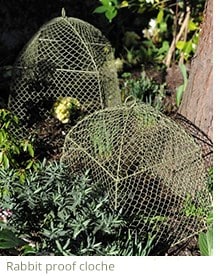 We all love wildlife in our gardens but not when they devour our favorite plants! Well there are cloches to prevent rabbits, deer, squirrels, slugs and even cats from devouring or scratching up your plants whilst they are establishing, or even for the long term if the plants are on the ‘hit list’!
The popular pyramid-shaped Rabbit Proof Cloche, is made from a woven wire around a frame which has been finished with a lichen green powder coating. These are light, tough and durable with spikes protruding from each corner, which help fix them securely into the ground. This prevents them from being knocked over by animals, including dogs or deer. These are perfect for protecting newly planted bulbs and stopping animals nibbling or trampling over your precious plants. There is even a Rabbit proof cloche extension which will raise the height of the standard for your taller plants. For smaller or individual plants the rabbit dome cloches take up less of a footprint in your garden but still offer the protection. We all love wildlife in our gardens but not when they devour our favorite plants! Well there are cloches to prevent rabbits, deer, squirrels, slugs and even cats from devouring or scratching up your plants whilst they are establishing, or even for the long term if the plants are on the ‘hit list’!
The popular pyramid-shaped Rabbit Proof Cloche, is made from a woven wire around a frame which has been finished with a lichen green powder coating. These are light, tough and durable with spikes protruding from each corner, which help fix them securely into the ground. This prevents them from being knocked over by animals, including dogs or deer. These are perfect for protecting newly planted bulbs and stopping animals nibbling or trampling over your precious plants. There is even a Rabbit proof cloche extension which will raise the height of the standard for your taller plants. For smaller or individual plants the rabbit dome cloches take up less of a footprint in your garden but still offer the protection.
There are many more cloches available, too many to mention but the Tent cloche and Long rabbit proof cloche are long, elegant cloches ideal for protecting rows of vegetables or seedlings on the allotment. Lightweight and easy to stack after use, which is always a consideration when space is limited.
The innovative Copper rimmed cloche is an attractive way to deter those pesky slugs and snails from devouring your vegetables and plants. As the name suggests the base has been encircled with a rim of copper which is known to deter slugs and the frame will also protect your plants from animals and birds. The Cloche with copper belt - scroll weave is similar in design but has a woven copper belt to discourage the slugs. For best results push the frame slightly into the ground, so the copper ‘belt’ is flush with the soil to dissuade any determined pest from getting at your plants.
 Finally it is worth mentioning the lovely woven willow and bamboo cloches. These will help to protect your plants from light frosts and cold winds. When it gets colder just line them with fleece or straw for that added protection. These gorgeous environmentally friendly cloches are perfect for the allotment and will blend in beautifully and complement naturalistic plantings of grasses and perennials. Finally it is worth mentioning the lovely woven willow and bamboo cloches. These will help to protect your plants from light frosts and cold winds. When it gets colder just line them with fleece or straw for that added protection. These gorgeous environmentally friendly cloches are perfect for the allotment and will blend in beautifully and complement naturalistic plantings of grasses and perennials.
|










